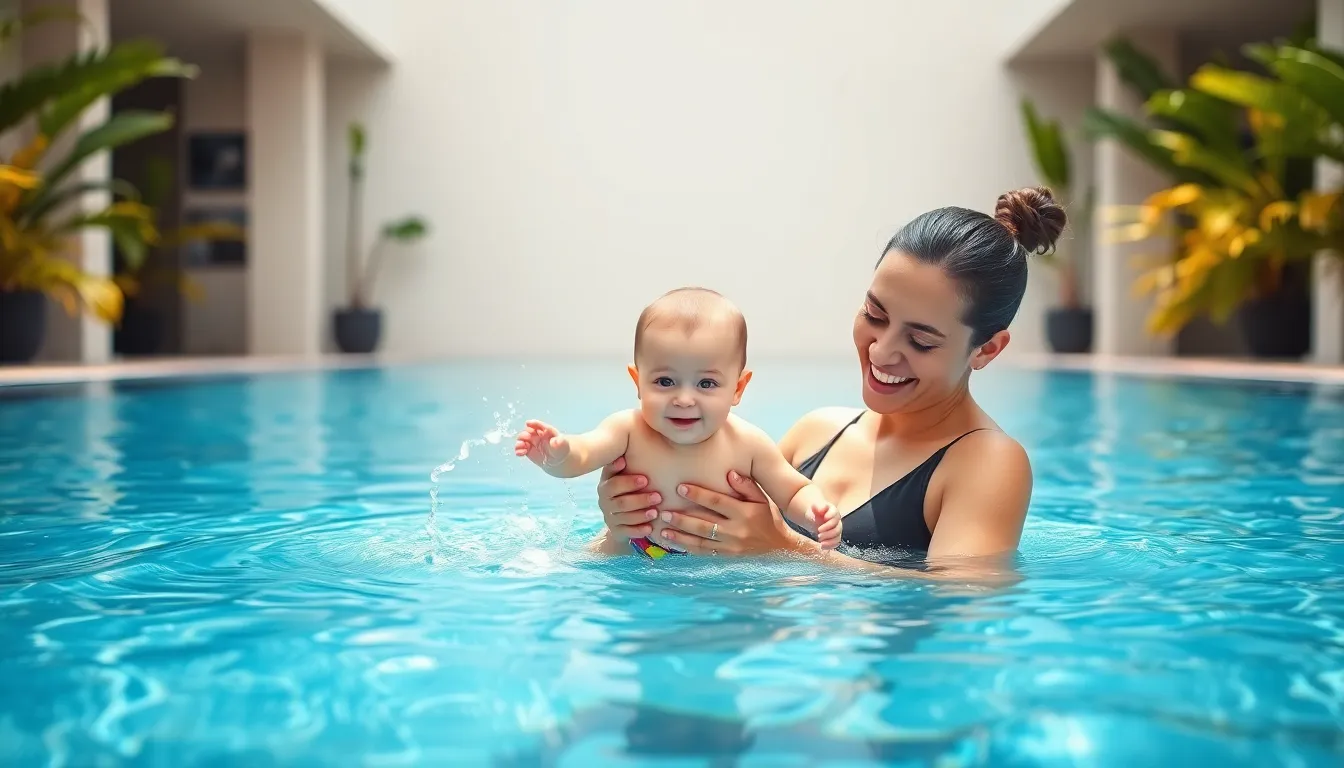Picture this: a tiny baby in a fluffy swim diaper, splishing and splashing in a pool, grinning from ear to ear. Sounds adorable, right? You might wonder, can babies swim? While the idea of little ones navigating the waters like tiny Michael Phelps is captivating, the reality is a bit more nuanced. From their first splashes to swimming lessons, there’s a lot to uncover about infants and water. Let’s immerse (pun totally intended) and discover the realm of baby swimming.
Table of Contents
ToggleUnderstanding Infants and Water

When it comes to babies and water, there’s plenty to consider. Infants are often comfortable in water thanks to their time spent in the womb. In fact, many parents report that newborns seem to naturally enjoy being in a pool. This love for water doesn’t mean they can swim, though.
Babies possess a reflex known as the swim reflex. This automatic response allows them to hold their breath and paddles their arms and legs if submerged. But, this is not a substitute for swimming skills. It’s vital for parents to understand that while this reflex may be present, it fades as the baby grows older, usually around six months.
So, while many babies react positively to water initially, they lack the strength, coordination, and understanding necessary for swimming. This knowledge lays the groundwork for why and how parents should introduce their little ones to swimming activities.
The Benefits of Early Swimming Lessons
Parents often inquire about the advantages of enrolling their babies in swimming classes as soon as they can. And the perks are plentiful.
Firstly, early swimming lessons can promote water safety. Teaching babies how to float and navigate their surroundings can prevent accidents later. Secondly, such lessons enhance physical development. They help strengthen muscles and improve coordination, essential aspects of any child’s growth. Swimming also introduces sensory experiences that stimulate brain development. Splashes, bubbles, and the feeling of water all contribute positively to a baby’s cognitive growth.
Also, swimming fosters stronger bonds between parent and child. Sessions often become shared moments filled with laughter and joy. There’s just something special about bobbing around in the water together.
Safety Considerations for Baby Swimming
While the benefits may seem enticing, safety must always be the priority. Drowning is a leading cause of accidental death among young children, which makes vigilance essential.
When introducing a baby to water, always maintain close supervision. Even in shallow water, a moment’s distraction can lead to disaster. Besides, equip babies with appropriate gear. Swim diapers prevent messes while keeping the pool clean, and flotation devices aid safety but should be used with caution. Remember, these devices are not life jackets.
It’s also crucial to choose age-appropriate classes taught by certified instructors. These professionals are trained not only in swimming techniques but also in safety practices. They can help guide parents in fostering a safe swimming environment.
When Can Babies Start Swimming?
Now, the big question is, when can babies start swimming? Experts generally agree that around six months is a good time to introduce infants to water activities. By this age, babies have developed enough muscle control and head support to begin safely exploring the water.
Many swimming schools offer programs for infants as young as six months. These classes typically focus on acclimatization rather than actual swimming techniques. Parents and babies engage in playful activities designed to promote comfort and confidence in the water.
As babies grow and gain skills, they can gradually transition into more structured lessons focusing on stroke techniques, breathing, and flotation.
Techniques for Teaching Babies to Swim
Teaching a baby to swim isn’t all about rigid instructions and drills. The focus should be on making it enjoyable. Here are some techniques:
- Start Slow: Begin by letting your baby get used to being in water, perhaps just sitting on the pool’s edge and splashing.
- Use Games: Incorporate fun games like blowing bubbles or floating toys to create a playful atmosphere.
- Hold Them Securely: Always keep a firm grip while letting them practice floating or kicking.
- Positive Reinforcement: Praise their efforts and celebrate milestones, no matter how small. This encouragement helps build their confidence.
By blending fun with learning, parents can cultivate a positive association with swimming, laying the foundation for future lessons.
Common Myths About Babies and Swimming
Misconceptions abound about babies and swimming. One prevalent myth is that all babies can swim naturally. While they may have a reflex response, it doesn’t translate into swimming proficiency. Also, some believe that swimming lessons should wait until the toddler stage. In reality, starting earlier can be beneficial, as discussed earlier.
Another common misunderstanding is that babies aren’t at risk of drowning in shallow water. Even a small amount of water can pose a danger. Finally, there’s a notion that pool water is too harsh for babies. Most public pools maintain appropriate chemical levels for safety, but parents should still take precautions like rinsing babies off afterward.

